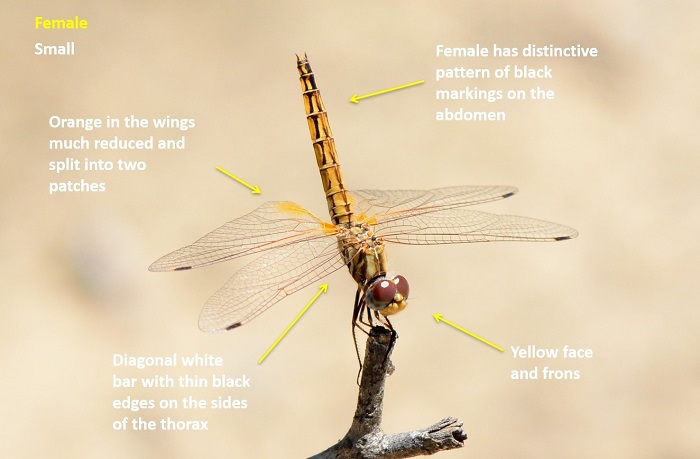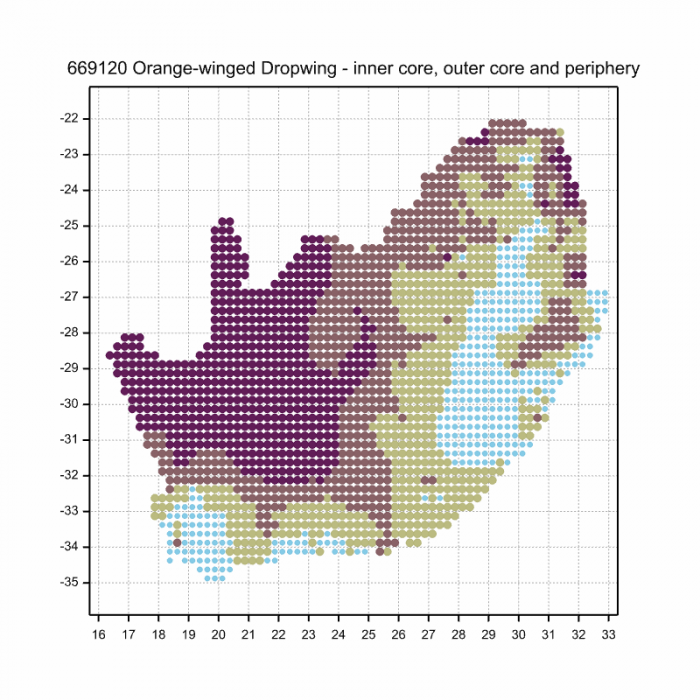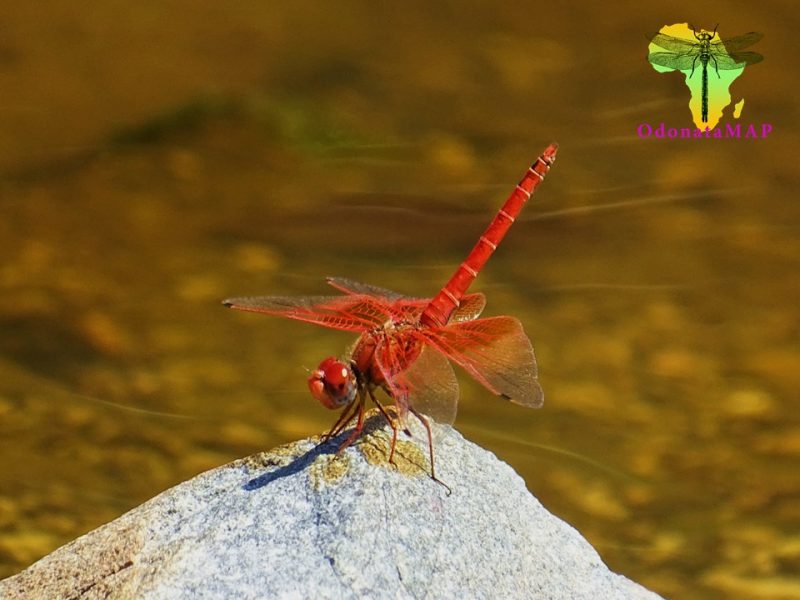Cover photo by Riëtte Griesel.
Find this species in the FBIS database (Freshwater Biodiversity Information System) here.
Family Libellulidae
Identification

Near Carnarvon, Northern Cape
Photo by Ryan Tippett
Small
Length up to 37mm; Wingspan up to 63mm
Both sexes of the Orange-winged Dropwing are readily identifiable. Males could be mistaken for the Red Groundling (Brachythemis lacustris), but are bright-orange-red (not deep red), and have slender abdomens with a tapered waist. The Orange-winged Dropwing also has a more elongate build, all black pterostigmas (not black and white), and unmarked red eyes.
Females are similar to other Trithemis species but can be separated on their distinctive abdomen pattern.
Click here for more details on identification.

Near Hluhluwe, KwaZulu-Natal
Photo by Ryan Tippett
Habitat
The Orange-winged Dropwing inhabits a wide range of natural and man-made water bodies, including rivers, streams, lakes, pans, dams, concrete reservoirs, swimming pools and drinking troughs. They prefer rocky habitats and areas with bare ground adjacent to the water. Bare concrete, gravel and bricks surrounding artificial water bodies provide ideal habitat. They can be found at both still and running water, and also make use of temporary and somewhat brackish water. Trithemis kirbyi can be particularly common at water points in dry arid regions.

Photo by Ryan Tippett
Behaviour
The Orange-winged Dropwing is a conspicuous species that sits in the open on rocks or bare ground and sometimes on branches or reeds. Females are often found near the males but are far less conspicuous. Males can be very active as they restlessly chase each other or intercept prey. The flight is rapid but not sustained and they quickly return to a perch. During hot conditions, Orange-winged Dropwings are often seen perched with their abdomens held vertically upwards (see image below). This is a form of thermoregulatory behaviour to minimise exposure to sunlight and thus prevent overheating. This is known as ‘obelisk posture’ or ‘sky-pointing’.

Near Upington, Northern Cape
Photo by Ryan Tippett
Status and Conservation
Trithemis kirbyi is an abundant and widespread species. It is listed as of Least Concern in the IUCN Red List of Threatened Species. Orange-winged Dropwings are highly adaptable and resitant to habitat change. They have made great use of man-made impoundments and have doubtless benefited from this. This species is often more prevalent at degraded habitats than in pristine areas.

Carnarvon district, Northern Cape
Photo by Ryan Tippett
Distribution
The Orange-winged Dropwing has a wide distribution. It is found virtually throughout Africa and in parts of the Middle East and southern Europe (Spain). It extends eastwards to India and Sri Lanka and also occurs on many islands in the Indian Ocean. The Orange-winged Dropwing occurs throughout southern Africa, including arid regions.
Below is a map showing the distribution of records for Orange-winged Dropwing in the OdonataMAP database as at February 2020.

Below is a map showing the distribution of records for Orange-winged Dropwing in the OdonataMAP database as of December 2024.

The next map below is an imputed map, produced by an interpolation algorithm, which attempts to generate a full distribution map from the partial information in the map above. This map will be improved by the submission of records to the OdonataMAP section of the Virtual Museum.


Ultimately, we will produce a series of maps for all the odonata species in the region. The current algorithm is a new algorithm. The objective is mainly to produce “smoothed” maps that could go into a field guide for odonata. This basic version of the algorithm (as mapped above) does not make use of “explanatory variables” (e.g. altitude, terrain roughness, presence of freshwater — we will be producing maps that take these variables into account soon). Currently, it only makes use of the OdonataMAP records for the species being mapped, as well as all the other records of all other species. The basic maps are “optimistic” and will generally show ranges to be larger than what they probably are.
These maps use the data in the OdonataMAP section of the Virtual Museum, and also the database assembled by the previous JRS funded project, which was led by Professor Michael Samways and Dr KD Dijkstra.

Mkuze River, KwaZulu-Natal
Photo by Ryan Tippett
Further Resources
The use of photographs by Riëtte Griesel is acknowledged. All other photographs by Ryan Tippett.
Orange-winged Dropwing Trithemis kirbyi (Gerstäcker, 1891)
Other common names: Kirby’s Dropwing, Scarlet Rock Glider (Alt. English); Oranjevlerk-valvlerkie (Afrikaans)
Recommended citation format: Loftie-Eaton M; Navarro R; Tippett RM; Underhill L. 2025. Orange-winged Dropwing Trithemis kirbyi. Biodiversity and Development Institute. Available online at https://thebdi.org/2020/02/26/orange-winged-dropwing-trithemis-kirbyi/
References: Tarboton, M; Tarboton, W. (2019). A Guide to the Dragonflies & Damselflies of South Africa. Struik Nature.
Samways, MJ. (2008). Dragonflies and Damselflies of South Africa. Pensoft
Samways, MJ. (2016). Manual of Freshwater Assessment for South Africa: Dragonfly Biotic Index. Suricata 2. South African National Biodiversity Institute, Pretoria
Martens, A; Suhling, F. (2007). Dragonflies and Damselflies of Namibia. Gamsberg Macmillan.

Near Vosburg, Northern Cape
Photo by Ryan Tippett

